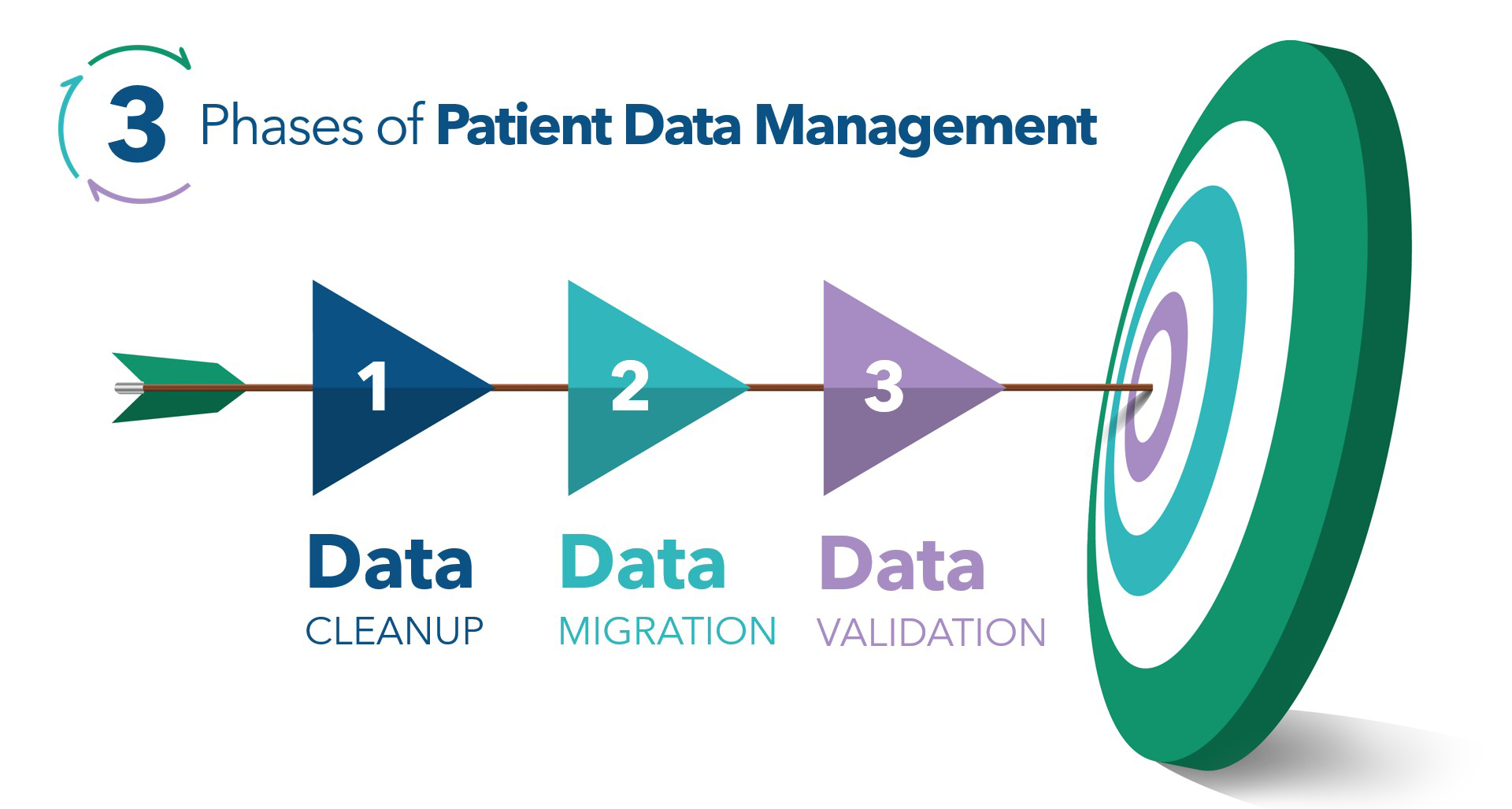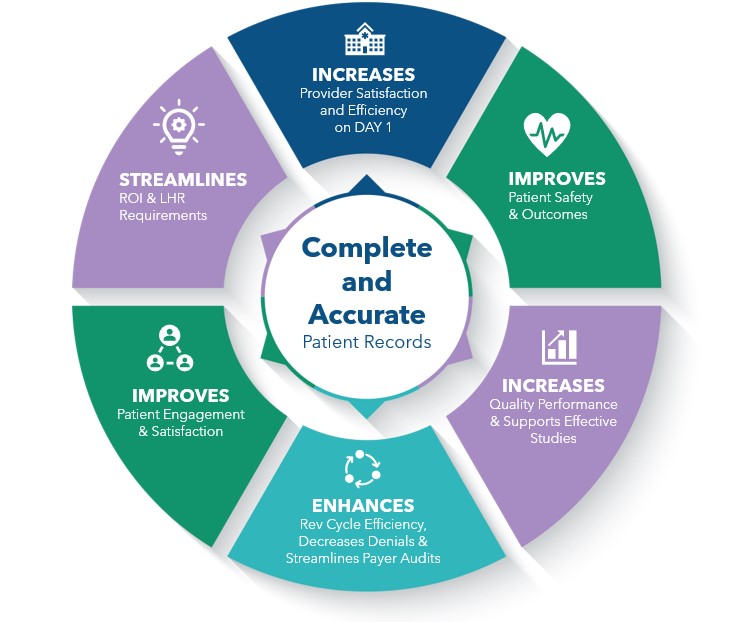Introduction
It is increasingly important for health systems to ensure the highest levels of data quality across the entire patient journey. Quality patient data is essential for EHR accuracy, patient safety and informed clinical decision-making.
Correct and complete patient information also improves end-user satisfaction and staff productivity while mitigating risk of revenue leakage and patient frustration. Furthermore, the benefits of health data quality increase exponentially as information is digitally shared across the healthcare ecosystem through interoperability and health information exchange.
With the U.S. predicted to spend $19.9B on EHRs by the end of 2024 and so much riding on the accuracy of patient data, now is the time for health systems to improve and protect the patient data they create. EHR vendors can’t, and won’t, do it all. Healthcare provider organizations (HCOs) must invest time, money and resources into their data quality programs. The downside cost is just too high.
In our work with health systems nationwide, we see five data quality areas commonly overlooked and unbudgeted during major EHR transitions.
These five areas all contribute to cleaner and more complete patient data:
- Data Strategy and Planning
- Patient Identity Management
- Data Migration and Validation
- Document Management
- Clinical Data Abstraction
This case study explores each of these steps and provides valuable advice for health IT leaders making major EHR and other IT system transitions in the year ahead.

Don't Ignore Patient Data Quality Red Flags
Further, health systems are often prepared and unbudgeted for what is required to achieve data accuracy across their EHRs and other IT systems.
Consider the following five industry statistics:
- 69% rated quality of enterprise patient as mixed or poor
- 71% rated poor quality impact on their enterprise goals as high
- $2K per stay and $800 per visit due to cost of inaccurate patient identification or information
- 17 recent Epic implementation plans lacked at least one essential data quality step (clean eMPI duplicates, abstract clinical data, or validated data)

Why Focus on Patient Data Quality Now?
IT systems changes aren’t only about IT. They are about engaging end users and operational teams. These are the staff that will use the new system every day and ensuring their buy-in adoption is essential. Begin your preplanning and strategy with this reality in mind.
Failure to focus on data quality up front leads to a deluge of IT issues and additional costs down the road. Furthermore, data quality isn’t a once and done effort. It builds over time and requires an executive commitment for the long term.
Improvements begin with IT leaders taking ownership of data quality within the EHR and other IT systems. Here are four main reasons to establish data quality programs now.
Ensure success of new EHRs and other IT systems:
The quality-first approach helps IT leaders maintain authority over vendors and applications during initial implementation and long-term as new systems become the source of truth for clinical care and reimbursement. It is your data, not theirs.
Optimize your analytics and AI:
Analytics and AI rely extensively on clean, accurate data. Dirty data leads to incorrect analytical outcomes and biased AI outputs.
Reduce your IT spend:
Legacy EHRs and other IT systems can be decommissioned in a timely manner once data is assessed, cleaned and migrated into the new system. Application rationalization and consolidation should be completed as soon as possible to reduce IT costs and achieve ROI during mergers and acquisitions.
Mitigate your security risks:
Fewer points of access to patient data from disparate systems minimizes the risk of information hacks and breaches.

Getting Started on the Road to Better Patient Data Quality
The journey begins with migrating accurate and complete historical patient data from legacy systems into new EHRs and other IT platforms. From there, IT teams should work with vendors and end users to ensure data quality at every step in the patient journey.
Savvy IT leaders also recognize the priority to guarantee information is accessible to all who need it, both within and outside the organization. This includes information stored in the EHR, housed in an archive platform, imaged in a document management system or PACS, and more. Since this patient data comes in many shapes and sizes, a comprehensive plan is crucial.
e4health knows the importance of building a comprehensive plan for better data quality in healthcare, over time and across departments.
We’ve served as data management partners for:
- Stepwise data migration planning
- Data migration and validation services
- Patient identifier accuracy audits and cleanup
- Ongoing patient data management, storage and archival
Data Strategy and Planning
Step 1: Data Strategy and Planning
EHRs and other IT systems are enormous investments for provider organizations. And EHR vendors are critical drivers of the system implementation and configuration. However, EHR vendors serve different roles related to the system being implemented and the data that will reside within it.
EHR vendors are typically a supporting contributor and advisor to the data quality plan while ownership of data quality remains with the provider organization. Data moving into the new system is your data, and an effective data quality plan should extend to systems beyond the EHR.
Assuming your EHR vendor will “take care of it all” is an unrealistic expectation. A comprehensive plan includes time and resources to address four main problem areas when incorrect data enters new systems.
These four areas include:
- Patient identity and enterprise master person index (eMPI) integration
- Data migration architecture and roadmap
- Duplicate record ID and merge process
- Clinical data abstraction education and planning where necessary
Implementation plans focused on data quality are critical for long-term system success and optimal ROI. With a comprehensive plan in place, patient identity management is the next risk area to address.
Patient Identity Management
A complete and accurate eMPI is the core foundation of any data quality plan. Patients must be correctly identified and established in go-forward systems. This ensures that physicians can easily find correct patient information every time they log in to a new EHR or other IT system.
Negative impacts of incorrect or duplicate data within an eMPI include:
- Physicians and registration staff struggle to find the correct instance of a patient
- Other legacy system content brought into the new system doesn’t match
- Manual prep work associated with a patient (e.g. appointment entry or clinical data abstraction) becomes problematic
Essential tasks related to data integrity at this stage of implementation include analyzing eMPIs for potential duplicate patients, remediating duplicate records, repairing conversion/interface errors, and correcting charts (overlay cleanup). Failure to perform these steps prior to data conversion to a new system costs time, money and end-user satisfaction for years ahead.

Data Migration and Validation
Step 3: Data Migration and Validation
3 Phases of Patient Data Management:
- Data Cleanup
- Data Migration
- Data Validation
Even the most sophisticated data migration techniques fall short when moving vital clinical information from legacy systems to the targeted EHR and other receiving systems. Legacy patient data must move to its new home accurately, and completely. The process is complicated, challenging and requires focused attention.
Common questions to ask during this step include:
- What data needs to be actively available within the EHR versus stored in an archive or document management platform?
- What retention requirements are needed for each data type?
- What do physicians need easy access to versus back office or HIM staff?
Completeness and accuracy are also fundamental to ensure patient safety and clinician satisfaction with the new EHR. An effective data migration and validation process delivers a cohesive and complete clinical picture for care providers on day one and improves clinician trust in migrated data. Each separate data type and destination requires a workplan and stakeholder involvement throughout the entire extract, transform, load, and validate (ETLV) process.
This process includes:
- Extract: manage multiple legacy vendors for the extraction process
- Transform: work with technology partners and EHR implementation team to properly transform content
- Load: coordinate with implementation team for load step
- Validate: research the validation process
Finally, clinical data elements—medications, allergies, immunizations, surgical histories, as well as family and social profiles—must be migrated and validated prior to use. These data elements are commonly referred to as patient problem, allergy, medication and immunization (PAMI) information.
Five-Point Data Migration Checklist:
- Experienced migration project management leadership
- Coordinate with the EHR implementation team for data transformation and load
- Dedicated data extraction and transformation team
- Adequate resources of the validation process
- Validation and testing coordination with expert SMEs and analysis
Document Management Still Plays a Role
Step 4: Document Management Still Plays a Role
Many physician practices still contain a lot of paper. To ensure day-one physician satisfaction, every piece of relevant patient information must be made available in the new system, regardless of format.
These five steps ensure no document is left behind:
- Know every information format and legacy system currently maintained by the physician practice being acquired.
- Define what information is relevant and how history should be transferred to the new system.
- Create summaries from legacy systems for physicians to use upon first patient encounter in the new system.
- Digitize other medical record documents including prep, scan, quality control and index.
- Purge, archive or destroy old paper records in accordance with state retention laws.
Clinical Data Abstraction
Step 5: Clinical Data Abstraction
How extensively an organization plans upfront (Step 1) plays a direct impact on whether clinical data abstraction is needed. In our experience, clinical data abstraction is usually a last-minute realization requiring a rushed effort to assemble an expert abstraction team.
Most organizations identify that some data points within the patient record cannot be easily or effectively migrated from a legacy platform in a systemic manner. In these situations, manual data abstraction may be the only solution.
However, data quality and integrity must be ensured. This makes the need for knowledgeable and reliable staff a vital part of every EHR patient data quality plan.
Clinical data abstraction is often needed in cases where acquired physician practices maintain paper, or legacy systems lack digitized data transfer capabilities. Again, PAMI data and medical histories are common pieces of information manually entered into new systems.
Finally, appointment conversions and other legacy documents, such as medical records from other providers, should be considered for manual abstraction and conversion into the new EHR.

Conclusion
The industry-proven best practices outlined in this white paper work together to safeguard patient data quality amid healthcare industry changes, overlapping
systems, EHR and other IT platform transitions, expansion of interoperability, and health information exchange (HIE).
IT leaders who commit to optimal patient data quality for each system implementation—and long-term across every step in the patient journey— ultimately improve our nation’s healthcare outcomes overall.
Together we can support optimal healthcare delivery, informed decision-making, and trustworthy patient-provider relationships. The first step is better patient data quality.